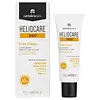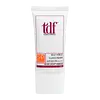What's inside
What's inside
 Key Ingredients
Key Ingredients

 Benefits
Benefits

 Concerns
Concerns

 Ingredients Side-by-side
Ingredients Side-by-side

Water
Skin ConditioningOctocrylene
UV AbsorberEthylhexyl Salicylate
UV AbsorberButyl Methoxydibenzoylmethane
UV AbsorberButylene Glycol
HumectantPhenylbenzimidazole Sulfonic Acid
UV AbsorberArginine
MaskingDimethicone
EmollientDiethylamino Hydroxybenzoyl Hexyl Benzoate
UV FilterPhenethyl Benzoate
EmollientSilica
AbrasiveTris-Biphenyl Triazine
UV AbsorberPolymethylsilsesquioxane
Styrene/Acrylates Copolymer
Polypodium Leucotomos Leaf Extract
Skin ProtectingEthylhexyl Triazone
UV AbsorberPhysalis Angulata Extract
Skin ProtectingPlankton Extract
Skin ConditioningMelanin
Skin ProtectingOxothiazolidine
Skin ProtectingSodium Hyaluronate
HumectantGlycerin
HumectantTrehalose
HumectantUrea
BufferingSerine
MaskingPullulan
Algin
MaskingC20-22 Alkyl Phosphate
EmulsifyingPhenylpropanol
MaskingC20-22 Alcohols
Emulsion StabilisingVp/Acrylates/Lauryl Methacrylate Copolymer
Sodium Acrylates Crosspolymer-2
AbsorbentAcrylates/C10-30 Alkyl Acrylate Crosspolymer
Emulsion StabilisingPropylene Glycol
HumectantCaprylyl Glycol
EmollientPropanediol
SolventPentylene Glycol
Skin ConditioningMethicone
EmollientCaprylic/Capric Triglyceride
MaskingDisodium Phosphate
BufferingGlyceryl Polyacrylate
Disodium EDTA
Tocopheryl Acetate
AntioxidantPotassium Phosphate
BufferingLecithin
EmollientBHT
AntioxidantSodium Benzoate
MaskingTocopherol
AntioxidantPhenoxyethanol
PreservativeParfum
MaskingLinalool
PerfumingLimonene
PerfumingWater, Octocrylene, Ethylhexyl Salicylate, Butyl Methoxydibenzoylmethane, Butylene Glycol, Phenylbenzimidazole Sulfonic Acid, Arginine, Dimethicone, Diethylamino Hydroxybenzoyl Hexyl Benzoate, Phenethyl Benzoate, Silica, Tris-Biphenyl Triazine, Polymethylsilsesquioxane, Styrene/Acrylates Copolymer, Polypodium Leucotomos Leaf Extract, Ethylhexyl Triazone, Physalis Angulata Extract, Plankton Extract, Melanin, Oxothiazolidine, Sodium Hyaluronate, Glycerin, Trehalose, Urea, Serine, Pullulan, Algin, C20-22 Alkyl Phosphate, Phenylpropanol, C20-22 Alcohols, Vp/Acrylates/Lauryl Methacrylate Copolymer, Sodium Acrylates Crosspolymer-2, Acrylates/C10-30 Alkyl Acrylate Crosspolymer, Propylene Glycol, Caprylyl Glycol, Propanediol, Pentylene Glycol, Methicone, Caprylic/Capric Triglyceride, Disodium Phosphate, Glyceryl Polyacrylate, Disodium EDTA, Tocopheryl Acetate, Potassium Phosphate, Lecithin, BHT, Sodium Benzoate, Tocopherol, Phenoxyethanol, Parfum, Linalool, Limonene
Cyclopentasiloxane
EmollientWater
Skin ConditioningZinc Oxide
Cosmetic ColorantTitanium Dioxide
Cosmetic ColorantButylene Glycol
HumectantIsotridecyl Isononanoate
EmollientPolyglyceryl-3 Polydimethylsiloxyethyl Dimethicone
Skin ConditioningPolymethylsilsesquioxane
Glycerin
HumectantPEG-9 Polydimethylsiloxyethyl Dimethicone
EmulsifyingAluminum Hydroxide
EmollientStearic Acid
CleansingDisteardimonium Hectorite
StabilisingPEG-40
HumectantHdi/Trimethylol Hexyllactone Crosspolymer
Triethoxysilylethyl Polydimethylsiloxyethyl Hexyl Dimethicone
Skin ConditioningSodium Chloride
MaskingEthylhexylglycerin
Skin ConditioningSodium Citrate
BufferingDipotassium Glycyrrhizate
HumectantSodium Hyaluronate
HumectantTocopherol
AntioxidantCyclopentasiloxane, Water, Zinc Oxide, Titanium Dioxide, Butylene Glycol, Isotridecyl Isononanoate, Polyglyceryl-3 Polydimethylsiloxyethyl Dimethicone, Polymethylsilsesquioxane, Glycerin, PEG-9 Polydimethylsiloxyethyl Dimethicone, Aluminum Hydroxide, Stearic Acid, Disteardimonium Hectorite, PEG-40, Hdi/Trimethylol Hexyllactone Crosspolymer, Triethoxysilylethyl Polydimethylsiloxyethyl Hexyl Dimethicone, Sodium Chloride, Ethylhexylglycerin, Sodium Citrate, Dipotassium Glycyrrhizate, Sodium Hyaluronate, Tocopherol
Ingredients Explained
These ingredients are found in both products.
Ingredients higher up in an ingredient list are typically present in a larger amount.
Butylene Glycol (or BG) is used within cosmetic products for a few different reasons:
Overall, Butylene Glycol is a safe and well-rounded ingredient that works well with other ingredients.
Though this ingredient works well with most skin types, some people with sensitive skin may experience a reaction such as allergic rashes, closed comedones, or itchiness.
Learn more about Butylene GlycolGlycerin is already naturally found in your skin. It helps moisturize and protect your skin.
A study from 2016 found glycerin to be more effective as a humectant than AHAs and hyaluronic acid.
As a humectant, it helps the skin stay hydrated by pulling moisture to your skin. The low molecular weight of glycerin allows it to pull moisture into the deeper layers of your skin.
Hydrated skin improves your skin barrier; Your skin barrier helps protect against irritants and bacteria.
Glycerin has also been found to have antimicrobial and antiviral properties. Due to these properties, glycerin is often used in wound and burn treatments.
In cosmetics, glycerin is usually derived from plants such as soybean or palm. However, it can also be sourced from animals, such as tallow or animal fat.
This ingredient is organic, colorless, odorless, and non-toxic.
Glycerin is the name for this ingredient in American English. British English uses Glycerol/Glycerine.
Learn more about GlycerinPolymethylsilsesquioxane is a silicone used as a film forming agent.
When applied to the skin, this ingredient creates an invisible film on the surface. This film still allows oxygen to pass through, but prevents moisture from escaping. This can help condition and hydrate the skin. It also leaves a silky feel when applied.
Polymethylsilsesquioxane has not been shown to clog pores. It has been deemed safe to use up to 55%, but most cosmetics use much less.
If you have concerns about using this ingredient, we recommend speaking with a professional.
Learn more about PolymethylsilsesquioxaneSodium Hyaluronate is hyaluronic acid's salt form. It is commonly derived from the sodium salt of hyaluronic acid.
Like hyaluronic acid, it is great at holding water and acts as a humectant. This makes it a great skin hydrating ingredient.
Sodium Hyaluronate is naturally occurring in our bodies and is mostly found in eye fluid and joints.
These are some other common types of Hyaluronic Acid:
Learn more about Sodium HyaluronateTocopherol (also known as Vitamin E) is a common antioxidant used to help protect the skin from free-radicals and strengthen the skin barrier. It's also fat soluble - this means our skin is great at absorbing it.
Vitamin E also helps keep your natural skin lipids healthy. Your lipid skin barrier naturally consists of lipids, ceramides, and fatty acids. Vitamin E offers extra protection for your skin’s lipid barrier, keeping your skin healthy and nourished.
Another benefit is a bit of UV protection. Vitamin E helps reduce the damage caused by UVB rays. (It should not replace your sunscreen). Combining it with Vitamin C can decrease sunburned cells and hyperpigmentation after UV exposure.
You might have noticed Vitamin E + C often paired together. This is because it is great at stabilizing Vitamin C. Using the two together helps increase the effectiveness of both ingredients.
There are often claims that Vitamin E can reduce/prevent scarring, but these claims haven't been confirmed by scientific research.
Learn more about TocopherolWater. It's the most common cosmetic ingredient of all. You'll usually see it at the top of ingredient lists, meaning that it makes up the largest part of the product.
So why is it so popular? Water most often acts as a solvent - this means that it helps dissolve other ingredients into the formulation.
You'll also recognize water as that liquid we all need to stay alive. If you see this, drink a glass of water. Stay hydrated!
Learn more about Water